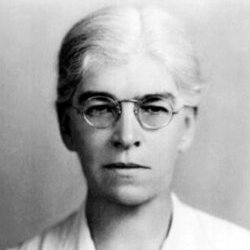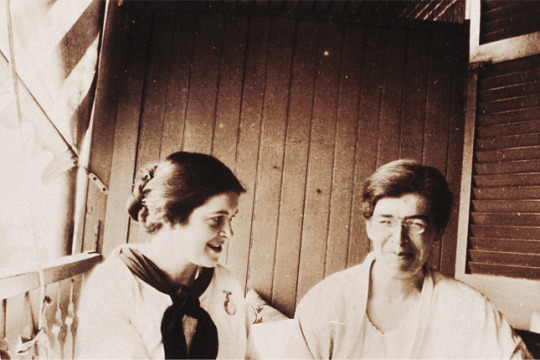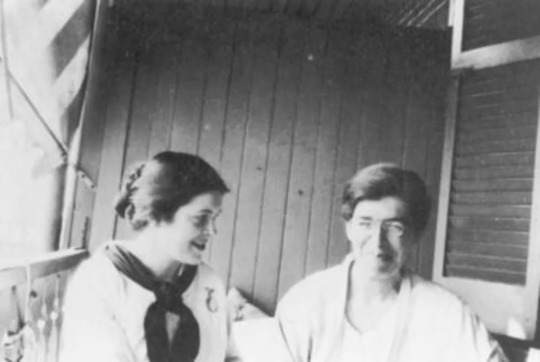#Ethel Collins Dunham
Text
at her easel, wandering
her knowledge and experience to
links; at her easel, puttering
with paints; Bureau
of Standards, that
manufacturers the babies
brought into her New Haven wandering
over Europe. And becoming
might
— OCR cross-column confusion, of —
For seven years after Farmington Ethel Dunham was an unexceptional young woman. She frittered her time away on the tennis courts and the golf links; at her easel, puttering with paints; wandering over Europe. And becoming...
—
somewhere in “Heart’s International, Combined with Cosmopolitan (1941) : link

but

the three-column source
—
Ethel Collins Dunham (1883-1969)
“After several years of travel and leisure pursuits, she decided she wanted to study medicine and enrolled in a physics class at Hartford High School.”
wikipedia
see also Pride Month Collection Highlight: Ethel Collins Dunham and Martha May Eliot (Harvard Countway Library guide) : link (June 8, 2013)
—
an accident of search, for Viña Delmar her “Born Actress” (in this volume)
1 note
·
View note
Photo


Ethel Collins Dunham (deceased)
Gender: Female
Sexuality: Lesbian
DOB: 12 March 1883
RIP: 13 December 1969
Ethnicity: White - American
Occupation: Doctor - Pediatrician, professor
Note 1: She established national standards for the hospital care of newborn children and expanded the scope of health care for growing youngsters by monitoring their progress in regular home visits by Children’s Bureau staff.
Note 2: First woman house officer at New Haven Hospital. She became one of Yale School of Medicine’s first female professors.
Note 3: Life partner of Martha May Eliot
#Ethel Collins Dunham#lgbt history#lesbian history#lgbt#lgbtq#female#lesbian#1883#rip#historical#white#doctor#Pediatrician#teacher#first#popular#popular post
111 notes
·
View notes
Text
MARCH 12: Dr. Ethel Collins Dunham (1883-1969)
Pioneering pediatrician Ethel Collins Dunham was born on this day in 1883. She and her partner, Martha May Eliot, revolutionized the way American hospitals cared for newborns and were among the first women appointed to Yale’s medical school faculty in 1920-21.

Ethel helped produce an instructional booklet for The Department of Labor’s Children’s Bureau in 1938. Titled Infant Care, the booklet educated new mothers on how to care for premature, ill, or injured babies.
Born in Hartford, Connecticut, Ethel was the daughter of a wealthy executive and was highly educated. She studied physics in high school and enrolled at Bryn Mawr College in 1901. It was there where she met the love of her life, Martha. After graduating, both women enrolled in medical school.
In a time when many women were still confined to the home, Ethel became the first woman to enter many high-profile roles in the medical field. She was the first ever female intern in Johns Hopkins’ pediatric department, the first woman house officer at New Haven Hospital, and also the very first female professor at the Yale School of Medicine. Partners in all aspects of their lives, whenever Ethel became the “first” to enter an institution, it wasn’t long before Martha became the second.

Ethel’s life partner, Dr. Martha May Eliot (1891-1978)
The two worked together throughout their lives, teaching, researching and even co-chairing The Children’s Bureau in the 1930s. One of their most profound contributions was publishing national guidelines for the hospital care of newborns and premature babies. Together, they raised America’s standard of childcare one hospital at a time and improved the lives of countless women by bringing health care education into the homes of new mothers.

The couple in a 1915 snapshot, courtesy Schlesinger Library, Radcliffe Institute, Harvard University.
Ethel and Martha were fairly open about their relationship, living among lesbian intellectuals in a New Haven community of “Boston marriages.” Martha often discussed her relationship with Ethel in letters back home, once writing to her mother that she was excited “to find out what the future will bring forth not only for me but for Ethel too.” Ethel and Martha’s letters to each other were loving and openly affectionate. Whenever work called for a temporary separation, they agonized over the distance: “Dearest, it was hard to say goodbye and I shall miss you terribly,” “I miss you my darling.”
In 1956, Ethel became the first woman to be awarded the American Pediatric Society’s highest honor, the John Howland Award. In 1967, Martha May Eliot, would, once again, become the second.
#ethel collins dunham#martha may eliot#lesbian history#gay history#lgbt history#lesbian archives#boston marriages#lesbian scientists#365daysoflesbians
38 notes
·
View notes
Text
list of people in history who were obviously lovers but historians say otherwise:
· Artemis and Callisto
· Eleanor Roosevelt and Lorena Hickok
· Hamilton and Laurens
· Sappho and the woman she wrote about
· Gertrude Stein and Alice B. Toklas
· Dorothy Arzner and Marion Morgan
· Ethel Collins Dunham and Martha May Elliot
· Virginia Woolf and Vita Sackville-West
· Lili Elbe and Gerda Gottlieb
· Michelangelo and Tommaso de Cavalieri
· Edith Anna Somerville and Violet Florence Martin
· Allen Ginsberg and Peter Orlovsky
· Walt Whiteman and Peter Doyle
· Radclyffe Hall and Evguenia Souline
· Wilfred Owen and Siegfried Sassoon
· Duke Ling and Mizi Xia
· Alexander the Great and Hephaestion
· Achilles and Patroclus
· Tennessee Williams and Frank Merlo
· Oscar Wilde and Lord Alfred Douglas
· Greta Gardo and Mercedes de Acosta
· W. Somerset Maugham and Gerald Haxton
· Anne Lister and Ann Walker
·Khnumhotep and Niankhkhnum
29 notes
·
View notes
Text
These two women revolutionized the medical industry. They were also madly in love.
by Rebecca Batley - LGBTQ Nation, March 7, 2024

Martha May Eliot and Ethel Collins Dunham, 1915 Photo: The Schlesinger Library, Radcliffe Institute, Harvard University via Wikimedia Commons
In honor of Women’s History Month, we’re highlighting some of the many incredible LGBTQ+ women of both the past and present, women who overcame unimaginable obstacles to change the world.
Martha May Eliot and Ethel Collins Dunham’s astounding medical achievements have largely been lost to history, overshadowed by the pair’s forbidden, impassioned love for one another, a love that persisted despite many efforts to destroy it.
But the effect both women had on the development of women’s healthcare, pediatric health, and LGBTQ+ acceptance in scientific circles cannot be overstated. While not many know their names, their impact lives on in the way our medical establishment operates today.
The hundreds of letters written by Eliot, held today at Harvard Library, provide a remarkable insight into the work of one of the twentieth century’s foremost pediatric and health specialists. They also detail her lifelong love affair with Collins, a fellow doctor. The letters boldly reveal just how openly the two women lived, refusing to conceal their true selves from anyone.
Both wrote to each other whenever they were apart, Eliot declaring over and over that she was “count[ing] the time until you do arrive. I miss you terribly my darling.” This openness in their private lives drew negative attention from many. Men like Senator James Reed (D) publicly called for society to address the problem of female “celibates”, as he called them, whose careers led to, as he argued, the“dangerous and laughable” consequence of women incapable of having babies or caring for them.
A deep & all-consuming love
Eliot was born in 1891 into the powerful and influential Eliot family, who were heavily involved in the establishment of the American education system in the 19th and 20th centuries. With money and a family who valued education behind her, Eliot entered Bryn Mawr College, where, in 1910, she met Dunham. The two fell quickly and deeply in love.
Dunham was the elder of the two by seven years. She was born in 1883, the daughter of a wealthy executive. She also had a somewhat bumpier road into her chosen career and had taken a break to travel before deciding to study medicine and resuming her schooling.
Eliot was a star straight-A student, but she delayed her graduation by a year so that she and Dunham could apply to medical school at the same time. From the start, the two women were inseparable. Despite their ferocious ambition, every choice they made was to prevent their careers from impacting their personal relationship, which was and always would be the bedrock of their lives.
Hiding in plain sight
Harvard Medical School refused to accept women at the time, but Eliot applied anyway and was turned down. Both women then applied to Johns Hopkins. When Dunham’s application was refused, Eliot turned down the position they offered her. Both women began to work in the medical field in Boston, where Dunham was so impressive that pediatric trailblazer Dr. John Howland agreed to admit her as a pediatric intern at Johns Hopkins.
With both women now studying medicine, rumors spread about the true nature of their relationship. They were kept apart as much as possible. Eliot was sent to St. Louis Children’s Hospital while Dunham was sent to Newhaven.
Both women excelled and quickly made a name for themselves. Eliot became fascinated by the study of social medicine and became determined to explore the links between living conditions and public health in relation to women and children.
To gain first-hand experience, she opened a clinic in Boston where she deliberately lowered her prices to undercut the established male doctors in the area. With this, she earned herself both their everlasting resentment and the respect of the local people, many of whom turned a blind eye to the fact that soon she was sneaking out of her university accommodation as Yale’s newly appointed physician in the pediatric department to sleep with Dunham.
Eliot was focused on the study and treatment of rickets, a childhood disease linked to poor nutrition and a lack of vitamin D. Working alongside Dr. Edwards A. Park, she developed revolutionary X-ray techniques to make early diagnoses and add vitamin D to children’s diets cheaply and effectively.
For helping her, Dr. Parks was hauled up before the board and charged with “supporting embattled feminists.” Members attacked him for accepting the two women’s romantic relationship. The courageous Dr. Park would always end his letters by reminding Martha to give his love to Ethel, which was used as proof of his ‘corruption.’ This is just one example of the threats faced professionally by both Eliot and Dunham and those who supported them, but their expertise and determination ensured that the board never succeeded in ousting them.
Meanwhile, in Newhaven, Dunham was undertaking a study of the health and mortality rate of infants with the support of the U.S. Children’s Department. Soon, the sight of her cheap battered car arriving outside a house signaled that help had arrived for the mother and infant within. She studied infant prematurity levels, assisted in developing and providing better healthcare, and created instruments capable of treating them.
An unstoppable team
Homophobia, however, continued to follow their careers. In 1935, they moved to Washington where Dunham was made chief of the Department of Child Development with Eliot as her assistant. The appointment horrified many; later the two women recalled that it was this period when they faced the most “aggressive levels of homophobia” of their whole career.
But they ploughed on, and soon they were battling to institute widespread healthcare reform, seeking to redress the balance between the survival rates of rich and poor children. Together, they were an unstoppable team, and slowly they gained widespread professional, if not always personal, acceptance.
Their reforms quickly yielded results, and both women were appointed to the World Health Organization (WHO). Eliot became the only woman to sign the WHO Constitution, and both women were recognized as world leaders in the field of neonatal and women’s public health.
In 1957, the American Pediatric Society awarded Dunham the John Howland medal, making her the first woman to receive the organization’s highest possible honor (Eliot was the second in 1967).
Dunham died in 1969 and Eliot in 1978. Dunham’s obituaries focused on her profession and sought to conceal the true nature of her relationship with Eliot. But their romance had been the foundation of their careers and their lives.
Today, their legacies endure. Awards are named in their honor, and their reformist policies are still the bedrock of the American public health system long after the names of their critics have been forgotten, a fact that would surely please them.
6 notes
·
View notes
Photo


Martha May Eliot (deceased)
Gender: Female
Sexuality: Lesbian
DOB: 7 April 1891
RIP: 14 February 1978
Ethnicity: White - American
Occupation: Doctor - pediatrician, professor
Note 1: Her first important research, community studies of rickets in Connecticut, & Puerto Rico, explored issues at the heart of social medicine. Together with Edwards A. Park, her research found that public health measures could prevent and reverse the early onset of rickets.
Note 2: She was responsible for drafting most of the Social Security Act’s language dealing with maternal and child health. During World War II, she administered the Emergency Maternity and Infant Care program, which provided maternity care for greater than 1 million servicemen’s wives.
Note 3: Became the first woman elected president of the American Public Health Association. She also was the first woman to receive APHA’s Sedgwick Memorial Medal.
Note 4: Life partner of Ethel Collins Dunham
#Martha May Eliot#lgbt history#lesbian history#lgbt#lgbtq#female#lesbian#1891#rip#historical#white#doctor#pediatrician#teacher#first#popular#popular post
203 notes
·
View notes